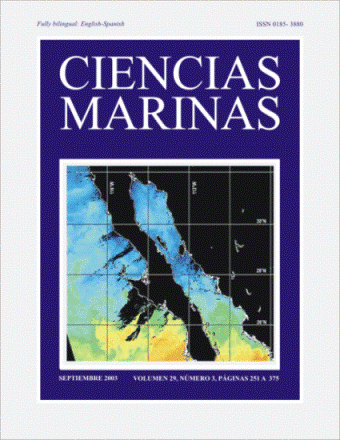Multiscale characterization of the sea temperature in an area of abalone banks (Haliotis spp.) at Bahia Asuncion, Baja California Sur, Mexico
Main Article Content
Abstract
The Baja California abalone is one of the most important Mexican fisheries because of its high economic value. Despite strong management efforts, this fishery has faced dramatic fluctuations attributed mainly to overfishing and variability of the marine climate. In this report we analyze sea temperature variability off Bahía Asunción, Baja California Sur (Mexico), at temporal scales that may affect abalone biological processes, such as mortality, reproduction, recruitment, and individual growth rate. Since the analysis is based on different data sources, we conducted a series of correlation analyses to determine the coherence between them. We report the average daily cycle and its variations throughout the year and between years for the period 1997–2000, the seasonal cycle and interannual deviations for the period 1992–2000, the behavior of the decadal scale variability based on annual values for the period 1959–1997, and the long-term trends after analyzing the entire 20th century. Furthermore, we conducted a spectral density analysis to estimate the proportional contribution of each temporal scale to the entire variability signal. Results from the high-frequency variability (daily to interannual) suggest a relationship between temperature and the abalone reproductive cycles, a potential negative effect of the very strong ENSO events on the postlarvae, and a differential effect of temperature on juveniles of different species. Regarding the low-frequency variability (decadal to century), we show that recent years represent a much warmer period compared to previous decades, suggesting a different biological community structure between periods. The spectral density analysis indicates seasonal variability as the major contributor to the regional variability, followed by the interannual (related to ENSO). There is almost no information of the marine climate in this region, particularly in regard to fine and high-resolution observations. This contribution will provide new quantitative elements for studies dealing with the ecology of these coastal productive systems.
Downloads
Article Details
This is an open access article distributed under a Creative Commons Attribution 4.0 License, which allows you to share and adapt the work, as long as you give appropriate credit to the original author(s) and the source, provide a link to the Creative Commons license, and indicate if changes were made. Figures, tables and other elements in the article are included in the article’s CC BY 4.0 license, unless otherwise indicated. The journal title is protected by copyrights and not subject to this license. Full license deed can be viewed here.

